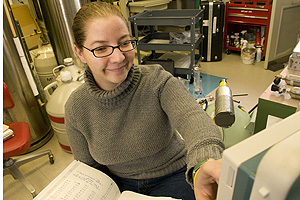Luce fellow works to add new knowledge about universe
By Greg Borzogregborzo@uchicago.edu
News Office
 Photo by Lloyd DeGrane Nicole Fields, winner of the 2008 Clare Boothe Luce Fellowship, records noise measurements for an experiment designed to determine whether neutrinos are their own antiparticles. |
|
Nicole Fields has a problem.
The recipient of a 2008-2009 Clare Boothe Luce fellowship is concerned that scientists do not understand the vast majority of the universe, which comprises dark matter and dark energy—an estimated 23 percent and 73 percent, respectively.
The Luce fellowship is aimed at encouraging women to enter, study and teach in the sciences, engineering and mathematics. The University received funding from the Henry Luce Foundation to offer four one-year graduate fellowships to female students entering the four departments in the Physical Sciences Division that have the lowest representation of women—Physics, Mathematics, Computer Science and Astronomy & Astrophysics.
The fellowships are for students entering in Fall 2008 and 2009, and Fields is the first fellow this time around. She is a first-year graduate student in Physics and comes to the University with a B.A. in Astronomy-Physics from the University of Virginia.
Determined to help unravel some of the mysteries of the universe, Fields is working with Juan Collar, Associate Professor in Physics, on an experiment to determine whether neutrinos are their own antimatter. An antimatter particle has the same mass but the opposite charge as its counterpart particle. Most particles have distinct antiparticles, but photons, for example, are their own antiparticle.
In another experiment, Fields, Collar and his colleagues at the University and collaborators at other universities are attempting to observe Weakly Interactive Massive Particles, commonly referred to as WIMPs. That can be pretty tough since no one knows whether they exist.
WIMPs are thought to be dark matter, an invisible form of matter that emits little or no detectable radiation. Dark matter is not well understood, but it may be largely composed of a variety of subatomic particles that have not yet been discovered.
“As dark matter candidates, WIMPs should be around us all the time,” Fields said. “WIMPs usually pass right through matter, but scientists theorize that if one scattered off an atomic nucleus, the nuclear recoil would excite electron hole pairs, which could be detected.”
In their search, Fields and her colleagues use a detector equipped with a germanium crystal kept at minus-320 degrees Fahrenheit by liquid nitrogen. This assures that the electron hole pairs are not thermally excited, as this would interfere with scientists’ ability to measure the interactions for which they are searching.
“The detector detects nuclear recoils, but we have not yet seen any signatures that match what we would expect from WIMPs,” Fields said. Therefore, the researchers continue to adjust the parameters of their search according to how heavy these mysterious particles might be and how they might interact.
The detector at the University is kept in the sub-basement of the Laboratory for Astrophysics and Space Research, in part to shield it from neutrons that could introduce radioactive atoms that would disrupt the results of the experiment. Currently, the researchers are painstakingly testing the detector to improve its noise characteristics and its energy resolution and threshold.
That suits Fields just fine. She describes herself as “a hands-on, trouble-shooting experimentalist.”
“Although the search is gradual and methodical,” she said, “the work is exciting, especially since researchers at other institutions are looking for the same thing. I love the competitive aspect of this experiment.”
She also enjoys the overall challenges of her field. “Too many students are intimidated by physics because of the jargon and required math, but I think all of that is fun,” she said.
Unfortunately, few female students agree with her. Only about 17 percent of graduate students in the Physics Department are women, the lowest level of any department in the Physical Sciences Division. The fellowship represents just one way the Division is working to increase the ranks and stature of women in the sciences.
“We hope that hosting Clare Boothe Luce Graduate fellowships will communicate to others that Chicago is an environment where female scientists can flourish academically and personally,” said Robert Fefferman, Dean of the Physical Sciences Division.
“We have assigned Fields a faculty mentor to help her attain her research and career goals. We also hope to get feedback on what we do well and where we need to improve in fostering an inviting atmosphere for women scientists,” he added. “We have other programs planned, including bringing in women speakers from other institutions to address issues that particularly affect women in science, such as balancing work and family.”
Fields’ mentor, Wendy Zhang, Associate Professor in Physics, laments the fact that historically women have been discouraged from studying science. “That’s no longer true, but the effects of that tradition linger,” she said. “Here, we are being extra vigilant to assure that talented women, like Nicole Fields, are welcomed into scientific fields.
“Luce fellowships are a great recruiting tool and will help us attract anyone who is good,” she added.
Fields would concur. “Sure, we need to encourage girls and women to study physics,” she said. “At the same time, we have to get out the word that everyone can study physics.”
![[Chronicle]](/images/sidebar_header_oct06.gif)